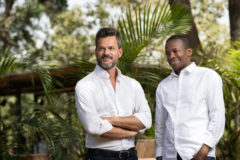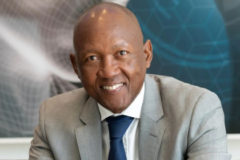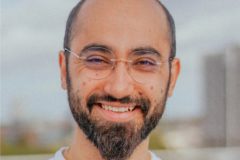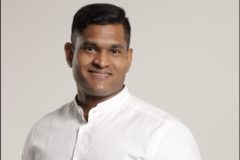For Satoshi Shinada, taking bets and investing is not something he just started doing.
At the age of 18, he took his first bet to invest in himself by leaving Japan to visit 40 African countries in the space of almost two years. I know what you’re thinking: “That’s bold! Why did he do this?” I had the same thought too, so I asked him about it.
“I was born and raised in Japan, so I wanted to expose myself to a different environment and culture. I also loved reading stories of adventures which exposed me to stories about Africa,” he told me over a Zoom call.
How was he able to afford the trip? He had just won a pact he made with his grandma. The deal was if he got admitted to the best university in Japan, the University of Tokyo, she’d give him an allowance. It turned out to be an allowance of $10,000.
In hindsight, Shinada believes he used the money for a better endeavour: instead of buying items, he bought experience. His experience crisscrossing Africa taught him that, even among diverse cultures, trading is a common language.
Before making the trip around Africa, he was conflicted on whether to become a researcher or a businessman. At the end of the trip, he had chosen to become a businessman.
In 2010, upon graduation from college, Shinada joined Sojitz, a Japanese company that led investment in infrastructure and energy projects in West Africa. At Sojitz, he was in charge of developing and investing in infrastructure and energy projects like the first desalination project in sub-Saharan Africa at a commercial scale. After seven years on the job, he itched to do something different.
He took some time off to return to Japan before heading to Harvard Business School for his MBA. Afterwards, he returned to Africa as a general partner at Kepple Africa Ventures.
“While at Sojitz, I had started becoming interested in Nigerian entrepreneurs starting their own businesses. I saw a lot of Africans who studied or lived in Europe and the US coming back to their home countries to start businesses that leveraged on new technologies. This was the opposite of the brain drain. I knew I had to be a part of it.”
Daniel Adeyemi: How did Kepple Africa Ventures start?
Satoshi Shinada: The origin of Kepple dates back to when Takahiro Kanzaki, a certified public accountant, left KPMG to provide accounting and back-office support for startups in Japan. After a few years, he saw that his startups turned out to be well-established companies and unicorns. So, he came up with the idea of creating Fundboard, a portfolio management software-as-a-service (SaaS) company for venture capitalists and private equity firms.
As a result of that decision, today Kepple is at the centre of the startup community in Japan with this tool. This provided Kepple with access to a network of investors to raise $18 million for Kepple Africa Ventures.
There are three persons involved in Kepple Africa ventures. Takahiro Kanzaki is in charge of fundraising from Japanese investors. Ryosuke Yamawaki handles investing in East and Southern African startups while I focus on investing in West and North African startups. Yamawaki started investing in Kenyan startups in 2018 while I started doing the same in Nigeria the following year.
DA: What’s Kepple’s investment thesis?
SS: Kepple Africa Ventures came to bridge two gaps. The first was the deep gap between seed and Series A because investors are very fragmented. We wanted to become an anchor investor in the seed stage for startups in Africa.
The second was, we wanted to bridge the mismatch between what African startups needed and the type of investors available in the ecosystem. We wanted to solve this problem by bringing more Japanese companies to invest directly in African startups and providing strategic support/capital, and in the end becoming an acquirer of the startups.
In Africa, you usually find financial investors and impact-driven social investors from Europe or the US, but you don’t find lots of strategic investors. These strategic investors are supported by the existing big businesses. They drive the growth of the startups through partnerships and end up even acquiring startups and giving exit opportunities to the ecosystems. You’ll find more of these strategic investors in India or Southeast Asia than in Africa.
So far, we’ve already facilitated Japanese companies listed on the Tokyo Stock Exchange to directly invest in our portfolio companies. In the past 10 months, we’ve brought four or five Japanese companies to directly invest into our portfolio companies.
DA: Hmm, that’s good to hear. What do you look for in the companies you invest in?
SS: First, I’d like to point out that our big vision is to create new industries from Africa. So we don’t consider our investment standalone. We want to create clusters of businesses that become new industries in Africa.
Now to answer your question, we lookout for the quality of the founders; they have to have a big vision to tackle real problems. Beyond having a big vision, they need to understand the biggest pain points of their customers. And why I say so is that in Africa it’s easy to mix up individual pains and social pains. For instance, deciding to tackle the pain point of poverty in Africa, although an important issue, doesn’t really help you to monetise your business model. Africa is also a place where it is very difficult to make people pay for your service.
So, your service or product should be really laser-focused on the biggest pain points of your customers and then you monetise that solution. We are not charity investors; we are commercial investors, so monetisation and revenue growth are very important.
DA: Are there any sectors you prefer to invest in?
SS: We’re sector agnostic, but we filter the startups we invest in based on four investment pillars. The first pillar is startups helping to complement or supplement the lack of public infrastructure. For example, we invested in a company called Flare. They are building an ambulance network for Africa. You know in Africa it’s difficult to access a reliable ambulance network, but by providing an Uber-like platform to the owners of ambulances and hospitals, they can create that kind of public service infrastructure of the ambulance network to make people’s lives better and safer.
The second pillar is startups that help businesses to digitise their operations and production, and make them more efficient. In this case, I’m talking about helping companies with a business-to-business (B2B) model, because in Africa, business-to-consumer (B2C) models are not as active as other markets in Southeast Asia or India.
The third pillar is focused on startups pioneering innovation where Africa does not have legacy infrastructure yet. Sometimes you can find leapfrogging technology from Africa and that technology could be applicable to other parts of the world. An example of this is one of our portfolio companies called Shyft Power in Nigeria. They automate the management of different power sources: grid of generators, solar power or batteries. They could commercialise this technology because in Nigeria many people don’t rely solely on power from the grid.
It’s not the same in Japan. If we need to develop that technology in Japan, we have to create a very artificial environment where power is not stable enough. Interestingly, in Japan we are seeing more solar power sources being introduced in each home and now they need to get this power generated by solar to be combined with the power coming from the grid and sell to their communities.
To wrap this up, the fourth pillar is about startups that facilitate African content created by Africans for Africans. That’s why we have invested in a company like Mdundo, which is seen as the African version of Spotify. We’ve also invested in a company called Athlst, which publishes first-person narratives of African athletes from around the world.
DA: You’ve invested in almost 100 startups within 3 years. That’s unusual. Why?
SS: Yes, it’s intentional for a number of reasons. We didn’t start out early in VC investing in Africa; we entered this market in 2018. But I think we came to the market at the right time. When we came in, the ecosystem had matured, so we thought it would make sense to bet on great startups quickly.
Our swift approach is modelled after one of the most successful VCs in Southeast Asia, BeeNext. BeeNext makes most of its returns from follow-up investments. So their first cheque is to get their feet in so many startups so they become an insider and know what’s going on in their portfolio companies. Once they see signs of exponential growth, they double down on their investment.
Another reason we invested in many startups was that we were new to the ecosystem, so we had to establish a reputation by increasing our presence so that we would access greater deal flow. Moving very fast and efficiently did that for us.
Furthermore, we wanted to challenge the perception that Japanese companies are slow. Japanese companies are notoriously known for their very slow decision-making process, compared to Indian or Chinese companies.
DA: How have you been able to combine speed and quality while investing in startups?
SS: That’s a good question, It’s always a balance between the quality and the speed. If you’re investing in seed-stage startups, you don’t have to do very detailed due diligence because one day the startup can decide to change its entire business model. This rarely happens in Series A. You just need to do more detailed due diligence on their product, tech, corporate governance and the founder.
For the seed-stage deals, it’s more based on your conviction and trust in the founders. If you can build enough trust and conviction, with the minimum amount of due diligence, you should go ahead. And that’s the strategy we took: we usually spend less than one month for due diligence when we invest in seed-stage deals. The quickest investment we’ve made took two weeks, from the first introductory call to wiring the capital.
DA: Tell me about some mistakes you’ve made?
SS: I’ve made a number of mistakes. One that stands out is investing in some startups that are trying to solve too many problems at the same time. It looks beautiful because the startup is solving everything and it involves different stakeholders in that sector. But a downside to this is that the startup struggles with monetisation for lack of understanding about their customer’s biggest pain point.
Another mistake that I made is caring too much about how we can connect startups with Japanese companies. A while back, some of the startups we brought to Japan got lots of attention from Japanese companies, but because the startups are at an early stage, the Japanese companies couldn’t invest. So we decided to be the first investor with these startups. But, as you know, when your investment decision is driven by excitement and not purely commercial criteria, it distorts healthy decision-making.
DA: Have you had any bad experiences with the startups? Has any startup in your portfolio gone bankrupt?
SS: I don’t have any business that went bankrupt in my portfolio companies.
We’ve had two companies that stopped operating, but it’s not like the founders just disappeared. We understood how it happened and the founders were serious enough to explain to us what’s going on. One of them even gave back 100% of the money that we invested. So, it wasn’t a very bad situation.
Initially, we thought we’d have many cases of the stories you hear about startups going under or disappearing because our investment has been driven more by conviction and trust with our founders than anything else, but that’s not happening yet. I think this is great validation.
DA: I see on your website it says you’ve stopped accepting applications. What’s happening?
SS: Yes, that’s true. Now we are in transition to our fund two. So we temporarily stopped accepting applications, but we still keep the form open and get about three to four applications per day. We think it’s very important to keep our doors open to any new startups.
Interestingly, about 85% of our investments was made into the startup that was introduced by one of our portfolio companies, or other co-investors. So the referral is the most important source of the deals. But if you just rely on that, you might miss someone coming from outside the network. So, we want to keep that door open for the outside.
DA: What’s your ticket size?
SS: We are focused on seed-stage deals. Our first cheque is between $50K and150K. Once we invest, we look at the revenue growth in our portfolio companies, and if it shows very dramatic growth, we will do a follow-up investment, which could be somewhere between $200K to $1 million. Where we invest $1 million, it would be a syndicate between other Japanese investors.
DA: Talking about Japanese investors, are there any other Japanese investors in Africa?
SS: There are a few other Japanese VCs, but unfortunately, none of them have their cooperation in Africa. They just go back and forth between Japan and Africa; they’re remote investors.
Compared to them, we think of ourselves as very much committed to Africa because of our background of doing business in Africa. We’ve noticed that a number of them just copy our investment deals. We don’t like this and aren’t comfortable with people just copying us while we’re on the ground bearing the cost of making investments.
DA: Hmm, so why are there not so many Japanese investors on the ground like Kepple?
SS: Well, I think it’s not as a result of the lack of capital or lack of willingness from the Japanese investors to invest in Africa; it’s more about the shortage of capable and experienced talents who can manage the funds in Africa. It’s very difficult to find talent who understand the African market and who can commit their lives to Africa.
I’m single, so it’s very easy for me to move around, but my partner Ryosuke, who is based in Kenya, had to bring his wife and two kids along with him. He’s really committed. His family has been around for a while such that his kids now speak Swahili.





















